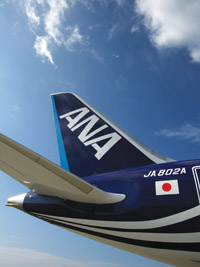Cover Story
June 1st 2012
Japan’s leading carrier also defies the odds
ANA’s peak performance Read More »
All Nippon Airways (ANA), Japan’s largest carrier by passenger numbers, like its rival, Japan Airlines (JAL), overcame the adversity and tragedy of 2011 by posting a 20.9% rise in net profit to 28.1 billion yen (US$351.7 million) in the financial year to March 31. Operating income rose 43.1% to a record 97 billion yen compared to 2010.
 |
| All Nippon Airways: Japan’s number one carrier aiming to become Asia’s top airline |
ANA implemented emergency cost-savings totalling 30 billion yen in 2011, brought forward elements of its 100 billion yen cost-reduction programme and merged with its wholly-owned subsidiary Air Nippon in order to streamline its operations and strengthen its bottom line.
Despite the effects of the earthquake and tsunami in March, 2011, ANA’s domestic market fared reasonably well during the year, with revenue passenger kilometres (RPKs) declining 3.9% to 34.6 billion. ASKs were trimmed 0.1% to 56.8 billion, which resulted in a 2.4% drop in load factor to 60.9% for the year.
This is a significant achievement as full-year revenue only fell marginally, 0.2% or one billion yen, to 651.5 billion yen, with positive signs the good news will continue from the third-quarter of the financial year throughout 2012.
Passenger traffic increased 4.8% to 8.4 billion and passenger revenue rose by 3.1%, to 154.2 billion yen, for the final quarter.
International passenger revenue rose 14% to 320 billion yen in 2011. Traffic and capacity rose 13% and 15.6% respectively, which prompted a 1.7% drop in load factor to 73.7%.
In the first three months of 2012, revenue increased 19.1% to 78.1 billion yen compared with the same period last year, buoyed by a 23.2% rise in international passenger numbers through fare discounts and promotions.
ANA is targeting a 42.3% rise in 2012 net income to 40 billion yen, with a 6% increase in operating revenue to 1.5 trillion yen.
One of the highlights of the year for ANA was the introduction of the Boeing 787 Dreamliner, for which it was the launch customer. The carrier has ordered 55 of the planes, 40 B787-8s and 15 of the larger -9 variant.
ANA expects the fleet to save 10 billion yen in fuel costs while expanding international capacity by 22% in the next five years.
The airline is continuing with its goal to become Asia’s number one airline and a proud boast of its president, Shinichiro Ito, last year’s recipient of Orient Aviation’s Person of the Year award, is that, unlike JAL, it has never had a yen of government support.
ANA will celebrate its 60th anniversary in December. Its major challenge for this year, like JAL, is extending its presence in the untapped Japanese low-cost sector.
It is adopting a decidedly different strategy to JAL, which is establishing an LCC joint venture, Jetstar Japan, with Qantas Airways. ANA, on the other hand, is launching two budget subsidiaries, Peach, which took off last month, and AirAsia Japan in partnership with Kuala Lumpur-based AirAsia.
Peach Aviation, which launched regional flights to Seoul in May, plans to carry six million passengers by 2017, an estimated 44% market share. The carrier will eventually deploy 31% of its initial capacity overseas.
AirAsia Japan will deploy 22% of its capacity overseas. Jetstar Japan also harbours plans for overseas operations.
At present, ANA and JAL control 80% of the domestic market. The third largest Japanese carrier, Skymark Airlines, has a market share of only 5%, despite the carrier’s planned foray into the long-haul, low-cost market. It has ordered six A380s and six A330-300s for the operation.
Research by OSK earlier this year reported the low-cost penetration rate in Japan was 9.1%, whereas a separate report by OAG said low-cost traffic in Asia was 25% of total passenger traffic in the region.
In comparison, Malaysia has an LCC penetration rate of over 57% and the Philippines 85%, according to consultant, CAPA, estimates.
As the barriers for Japan’s LCCs start to crumble, including the Ministry of Land, Infrastructure and Transport (MLIT) cutting the domestic fuel tax to 18,000 yen per 1,000 litres of fuel, Narita airport’s plan to build a low-cost terminal and an expansion in Japan’s Open Skies accord will help create a solid foundation for the no-frills carriers.
The three new LCCs will be charging fares up to 66% less than ANA and JAL ticket prices.